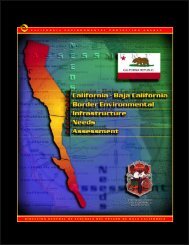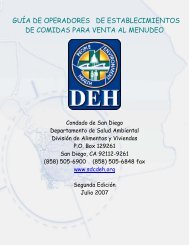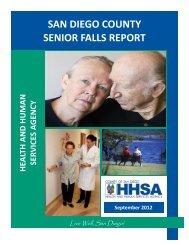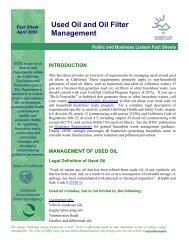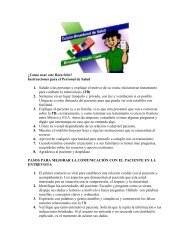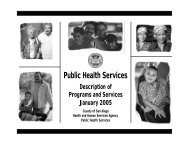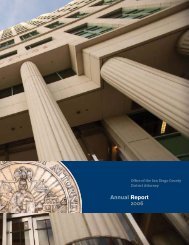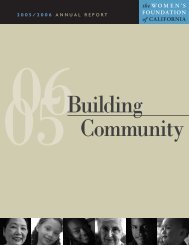Project Dulce Transfer Guide - San Diego Health Reports and ...
Project Dulce Transfer Guide - San Diego Health Reports and ...
Project Dulce Transfer Guide - San Diego Health Reports and ...
You also want an ePaper? Increase the reach of your titles
YUMPU automatically turns print PDFs into web optimized ePapers that Google loves.
UNITED STATES-MEXICO<br />
COMMUNITY HEALTH WORKERS<br />
BORDER MODELS OF EXCELLENCE<br />
<strong>Transfer</strong>/Replication<br />
Strategy<br />
<strong>Project</strong> <strong>Dulce</strong> Model<br />
County of <strong>San</strong> <strong>Diego</strong>, California<br />
2004
Table of Contents<br />
1. Director’s Letter of Support<br />
2. General Information on Roles of CHWs/Promotores(as)<br />
3. <strong>Project</strong> Profile<br />
4. <strong>Project</strong> Description<br />
5. <strong>Health</strong>y Border 2010 Focus Areas<br />
6. Population Served<br />
7. <strong>Health</strong> Related Outcomes<br />
8. Selection <strong>and</strong> Training of Staff<br />
9. Sustainability <strong>and</strong> Replicability<br />
10. Partnerships <strong>and</strong> Collaborations<br />
11. Greatest Community Impact<br />
12. Administration<br />
13. Roles <strong>and</strong> Empowerment of CHWs/Promotores(as)<br />
14. Lessons Learned <strong>and</strong> Overcoming Barriers<br />
15. <strong>Guide</strong>lines for Model Implementation<br />
16. Questions to Keep in Mind<br />
17. Funding <strong>and</strong> Resource Development<br />
18. Conclusions<br />
19. Contact Information<br />
20. Reference to tools <strong>and</strong> additional resources<br />
1
Border Models of Excellence Background<br />
The purpose of the Border Models of Excellence initiative is to recognize the<br />
community-based health programs <strong>and</strong> initiatives along the United States -<br />
Mexico border that have made great strides in improving the health <strong>and</strong> wellbeing<br />
of communities along either side of the 2000 mile border. The USMBHC<br />
celebrates the accomplishments of these programs through Border Models of<br />
Excellence (BMOE).<br />
The primary purpose of this initiative is to:<br />
• Identify best projects <strong>and</strong> models;<br />
• Build the capacity of existing programs <strong>and</strong> models that address the focus<br />
themes of <strong>Health</strong>y Border 2010; <strong>and</strong>,<br />
• Emphasize <strong>and</strong> support the transfer <strong>and</strong> sharing of successful strategies<br />
across states <strong>and</strong> along the U.S. – Mexico border region.<br />
In its first phase, BMOE focused on programs that were using the Community<br />
<strong>Health</strong> Worker (CHW) / promotor(a) approach <strong>and</strong> that had been in existence for<br />
a minimum of 12 months. CHWs/Promotores(as) have played a key role in<br />
addressing health issues of border communities. The BMOE initiative<br />
commenced its first call for applications in October 2002. Criteria for selection of<br />
the winners included the following:<br />
• Having a presence on the United States – Mexico border<br />
• Utilization of CHWs/Promotores(as)<br />
• Being innovative<br />
• Being responsive to community needs<br />
• Possessing outcome capability<br />
• Demonstrating measurable quality improvement<br />
• Being collaborative in nature<br />
• Having the ability to be replicated <strong>and</strong> sustained<br />
• Demonstrating administrative effectiveness<br />
• Focusing on at least one of the <strong>Health</strong>y Border 2010 focus areas<br />
What are Community <strong>Health</strong> Workers/Promotores(as)<br />
Community <strong>Health</strong> Workers (CHWs) are also known as<br />
community health advocates, lay health educators, community<br />
health representatives, peer health promoters, community<br />
health outreach workers, <strong>and</strong>, in Spanish, promotores de<br />
salud. They are community members who work almost<br />
exclusively in community settings. They serve as connectors<br />
between health care consumers <strong>and</strong> providers to promote<br />
health among groups that have traditionally lacked access to<br />
adequate health care.<br />
-A. Witmer, 1995<br />
3
Community <strong>Health</strong> Workers (CHWs)/Promotores(as) represent their community’s<br />
cultural, linguistic, educational, <strong>and</strong> economic characteristics. They advocate for<br />
their community’s health care <strong>and</strong> social needs <strong>and</strong> assist members of their<br />
community in accessing health care <strong>and</strong> social services. As members of their<br />
communities, they personally share in the community’s stake to reduce barriers<br />
that impact the quality of life.<br />
CHWs/Promotores(as) can be found in a variety of health care <strong>and</strong> community<br />
settings including clinics, hospitals, community centers, churches, agricultural<br />
fields, libraries, shelters, <strong>and</strong> in their own neighborhoods. CHWs/Promotores(as)<br />
utilize <strong>and</strong> build upon their pre-existing relationship with the community being<br />
served to connect <strong>and</strong> empower their peers. This ever-growing cadre of health<br />
support workers play many important roles in underserved <strong>and</strong> uninsured<br />
communities. According to the National Community <strong>Health</strong> Advisor study,<br />
among these are the following:<br />
‣ Bridging cultural mediation between communities <strong>and</strong> the health <strong>and</strong><br />
social service systems<br />
‣ Providing culturally appropriate <strong>and</strong> accessible health education <strong>and</strong><br />
information<br />
‣ Assuring that people get the services they need<br />
‣ Providing informal counseling <strong>and</strong> social support<br />
‣ Advocating for individual <strong>and</strong> community needs<br />
‣ Providing direct services<br />
‣ Building individual <strong>and</strong> community capacity<br />
Latin America has a long <strong>and</strong> successful tradition of integrating<br />
CHWs/Promotores(as) into the health delivery system. By working bilaterally,<br />
expertise <strong>and</strong> experience can be cross-pollinated on both sides of the United<br />
States – Mexico border. It is the Commission’s aim to recognize the critical work<br />
that CHWs/Promotores(as) carry out in their border communities <strong>and</strong> create a<br />
network of cooperation, technical support, professional training, <strong>and</strong> replication<br />
services for the organizations <strong>and</strong> agencies that utilize them.<br />
Trends in Certification of CHWs/Promotores(as)<br />
The st<strong>and</strong>ardization of CHW/Promotor(a) skills <strong>and</strong> knowledge is not considered<br />
positive by all proponents of the CHW/Promotor(a) model. There is concern that<br />
the st<strong>and</strong>ardization of skills <strong>and</strong> knowledge will detract from the abilities of<br />
CHWs/Promotores(as) to relate to the community as a member of that<br />
community -- the very strength of the CHW/Promotor(a) model. In other words,<br />
skills <strong>and</strong> knowledge that are community-specific are strengths that enable<br />
CHWs/Promotores(as) to better identify with <strong>and</strong> serve their particular<br />
community. Many individuals from the community do not have time, finances, or<br />
transportation to participate in certification programs that require a significant<br />
commitment of time <strong>and</strong> personal resources.<br />
4
The certification of CHWs/Promotores(as) is promoted by some as a means for<br />
CHWs/Promotores(as) to receive reimbursement for their work. The Texas<br />
Department of <strong>Health</strong> Office of Public <strong>Health</strong> Promotion implemented a<br />
certification program that facilitates achievement of st<strong>and</strong>ardized core<br />
competencies in communication, interpersonal skills, service coordination,<br />
capacity-building, advocacy, teaching, organization, <strong>and</strong> knowledge based skills.<br />
The certification program aims to assure uniformity <strong>and</strong> transferability of skills<br />
<strong>and</strong> knowledge among all certified CHWs/Promotores(as). Texas, through the<br />
Texas Department of <strong>Health</strong>, is the first state to implement a st<strong>and</strong>ardized<br />
certification program for CHWs/Promotores(as).<br />
The state of Arizona has also instituted a CHW/promotor(a) certification program<br />
in coordination with the University of Arizona. While in the Legislative Session<br />
2003, New Mexico State Legislators passed the Senate Joint Memorial (076) that<br />
tasked the Department of <strong>Health</strong> to “lead a study on the development of a<br />
Community <strong>Health</strong> advocacy Program in NM. This study estimated that there are<br />
approximately 500 CHW’s/Promotores (as) providing health related services in<br />
NM. On tribal l<strong>and</strong>s there are an estimated 150 CHW’s <strong>and</strong> 150 in the southern<br />
border region providing services of Hispanic, Native American, Anglo <strong>and</strong> other<br />
ethnic populations. The CHW’s provided Medicaid enrollment, case<br />
management, health education, translation, <strong>and</strong> client advocacy in both urban<br />
<strong>and</strong> rural communities.<br />
Many CHWs/Promotores(as) are paid by their individual programs based on<br />
available funding from grants. This reimbursement does not require a<br />
certification. Likewise, having a certification would not gain reimbursement for<br />
the program if it didn’t have the available finances. Program funding does not<br />
depend on CHW/Promotor(a) certification nor does it seem to increase a<br />
program’s chances to receive funding.<br />
Profile for <strong>Project</strong> <strong>Dulce</strong><br />
<strong>Project</strong> <strong>Dulce</strong> combines peer-led education <strong>and</strong> support with quality diabetes<br />
care to achieve lasting improvements in health status <strong>and</strong> health-related<br />
behaviors among Latinos <strong>and</strong> other underserved populations in <strong>San</strong> <strong>Diego</strong><br />
County, California. Nurse-led teams provide clinical diabetes management while<br />
trained peer educators provide diabetes self-management training <strong>and</strong> support.<br />
Access to care is enhanced by the program’s integration with the services of<br />
community health centers.<br />
<strong>Project</strong> Description<br />
Established in 1997, <strong>Project</strong> <strong>Dulce</strong> was designed through a dynamic<br />
collaborative process between three primary partners, the Whittier Institute for<br />
Diabetes, the <strong>San</strong> <strong>Diego</strong> Council of Community Clinics, <strong>and</strong> <strong>San</strong> <strong>Diego</strong><br />
Community <strong>Health</strong> Improvement Partners, along with over 20 community-based<br />
groups <strong>and</strong> healthcare organizations.<br />
5
<strong>Project</strong> <strong>Dulce</strong>’s vision is to eliminate disparities in health status by specifically<br />
addressing the high prevalence of uncontrolled diabetes among Latinos <strong>and</strong><br />
other ethnic groups. The primary goal is to prevent the devastating health<br />
impacts of diabetes by ensuring that the most vulnerable in their communities<br />
receive appropriate screening <strong>and</strong> diagnosis, <strong>and</strong> are provided the education <strong>and</strong><br />
ongoing support they need to manage their diabetes. The program addresses<br />
cultural, economic, language, <strong>and</strong> other barriers to care.<br />
<strong>Health</strong>y Border 2010 Focus Area:<br />
• Diabetes hospitalization <strong>and</strong> mortality<br />
Population Served<br />
It is estimated that there are approximately 172,000 persons with diagnosed<br />
diabetes in <strong>San</strong> <strong>Diego</strong>, <strong>and</strong> at least that many have diabetes but have not yet<br />
been diagnosed. One- third of those diagnosed with diabetes in <strong>San</strong>d <strong>Diego</strong> is<br />
Latino, <strong>and</strong> a significant proportion of Latinos in <strong>San</strong> <strong>Diego</strong> County reside in the<br />
border region.<br />
The devastating complications of diabetes impact Latinos more than other<br />
populations because they are uninsured; there is a lack of bilingual/bicultural<br />
health providers; <strong>and</strong> there is a lack of diabetes education programs that address<br />
the complex family, social, cultural, linguistic <strong>and</strong> economic factors that impact<br />
Latinos.<br />
<strong>Project</strong> <strong>Dulce</strong> focuses on reducing mortality <strong>and</strong> morbidity from diabetes-related<br />
conditions through prevention education <strong>and</strong> peer support to increase knowledge<br />
<strong>and</strong> facilitate healthy behavior change. <strong>Project</strong> <strong>Dulce</strong> was initially designed to<br />
address the needs of Latinos, who bear the brunt of the diabetes epidemic. The<br />
diabetes epidemic has its most severe impact on ethnic populations, <strong>and</strong> Latinos<br />
get diabetes at 2-3 times the rate of Whites. The latest statistics show that nearly<br />
half of all Latino children born in 2000 will get diabetes at some time in their lives.<br />
In <strong>San</strong> <strong>Diego</strong>, one-third of those diagnosed with diabetes are Latino, <strong>and</strong> a<br />
significant proportion of Latinos in <strong>San</strong> <strong>Diego</strong> County reside in the border region.<br />
Underserved Latinos continue to comprise the majority of individuals served by<br />
<strong>Project</strong> <strong>Dulce</strong>.<br />
Diabetes education classes are conducted at each partnering community health<br />
center (CHC) <strong>and</strong> at numerous community sites, such as churches or parks. The<br />
education model is adapted to the operating specifications at each clinic site.<br />
<strong>Health</strong> Related Outcomes<br />
<strong>Project</strong> <strong>Dulce</strong> has seven years of experience <strong>and</strong> data to validate the power <strong>and</strong><br />
effectiveness of the use of the CHW/Promotor(a) model. <strong>Project</strong> <strong>Dulce</strong> measures<br />
outcomes using three primary methods:<br />
6
1) Clinical outcomes are measured with the aid of an electronic diabetes<br />
registry (DEMS), a st<strong>and</strong>-alone system that was developed specifically for<br />
community health centers with support from the US Public <strong>Health</strong><br />
Services. Key clinical <strong>and</strong> demographic information from patient visits<br />
with the nurse educator is entered into this system, including lab results,<br />
<strong>and</strong> adherence to ADA st<strong>and</strong>ards of care. DEMS enables <strong>Project</strong> <strong>Dulce</strong> to<br />
report the percent change in lab values over time, the percent of patients<br />
who are meeting ADA goals, <strong>and</strong> the numbers who receive care according<br />
to the recommended guidelines, e.g., 2 HbA1cs per year, one retinal<br />
exam, etc.<br />
2) A behavior change evaluation is conducted for all participants in <strong>Project</strong><br />
<strong>Dulce</strong> classes <strong>and</strong> in the clinical component. A validated instrument is<br />
used (Toolbert <strong>and</strong> Glasgow) that gathers information from the participant<br />
regarding their exercise, nutrition, medication compliance, <strong>and</strong> glucose<br />
monitoring behavior. These tools are administered when the participant<br />
enters the program <strong>and</strong> at 3, 6, <strong>and</strong> 12 months post enrollment. Results<br />
are analyzed on a quarterly basis <strong>and</strong> provide feedback to the program<br />
<strong>and</strong> its educators regarding the effectiveness of the education content <strong>and</strong><br />
methods.<br />
3) Knowledge is pre-tested before classes <strong>and</strong> after the 8-week series to<br />
determine the level of learning that has taken place. Pre-tests are also<br />
used by the educators to identify areas on which to focus during the<br />
classes.<br />
In the pilot project (1998-1999), high-risk patients showed significant<br />
improvements in HbA1c, a biological indicator of diabetes control; total<br />
cholesterol; systolic blood pressure, <strong>and</strong> diastolic blood pressure . Pre- <strong>and</strong><br />
post-test evaluations showed improved diabetes knowledge (p=.024), treatment<br />
satisfaction (p=.001) <strong>and</strong> internal locus of control (p=0.04). Compliance was<br />
100% in the <strong>Dulce</strong> treatment group in obtaining HbA1c, lipids, urine<br />
microalbumin, <strong>and</strong> foot exams, while the controls had 28%, 46%, 31%, <strong>and</strong> 15%,<br />
respectively.<br />
As <strong>Dulce</strong> has evolved from a research-oriented pilot project to a program that<br />
operates throughout <strong>San</strong> <strong>Diego</strong> County, clinical <strong>and</strong> behavioral outcomes<br />
continue to be tracked, along with compliance with st<strong>and</strong>ards of care. These<br />
results are reported to the clinics on a quarterly basis. Evaluation of behavior<br />
change also indicates statistically significant improvements in nutrition, exercise,<br />
glucose testing, <strong>and</strong> medication compliance.<br />
The program has demonstrated statistically significant improvements in clinical<br />
indicators of diabetes management including reduction in HbA1c <strong>and</strong> in Total<br />
Cholesterol. Below are the results from the pilot.<br />
7
14<br />
Figure 1.Change in Hba1c<br />
HbA1c (%)<br />
12<br />
10<br />
8<br />
6<br />
4<br />
2<br />
0<br />
HbA1c Baseline<br />
10.4<br />
p
Sustainability <strong>and</strong> Replicability<br />
<strong>Project</strong> <strong>Dulce</strong> is innovative in its service delivery of care at a community health<br />
center. Nurses do much of the work of physicians, <strong>and</strong> promotoras do much of<br />
the work of nurse educators. Regular feedback, communication, <strong>and</strong> problem<br />
solving between the <strong>Project</strong> <strong>Dulce</strong> team <strong>and</strong> clinic providers is key to success.<br />
Administrative <strong>and</strong> clinical champions at the implementation site are instrumental<br />
in keeping the lines of communication open.<br />
Systematic documentation of outcomes is essential <strong>and</strong> one of <strong>Project</strong> <strong>Dulce</strong>’s<br />
best practices. Clinical <strong>and</strong> behavioral improvements in patient status are<br />
constantly recorded.<br />
<strong>Project</strong> <strong>Dulce</strong> is designed to be financially self-sustaining in a community health<br />
center setting. It can also be sustained in other provider environments,<br />
depending upon the reimbursement policies of the primary payers.<br />
<strong>Project</strong> Dulece’s ability to provide clinical <strong>and</strong> social support while using forging<br />
partnerships with academic experts in the fields of social <strong>and</strong> behavioral science,<br />
organizational psychology, clinical diabetes care, health promotion, biostatistics<br />
<strong>and</strong> epidemiology, <strong>and</strong> healthcare economics in order to ensure its program<br />
employs leading edge strategies <strong>and</strong> methods to reach its goals may be the<br />
secret to its sustainability over the past seven years.<br />
Extensive cultural research, including focus groups <strong>and</strong> key informant surveys, to<br />
adapt curriculum <strong>and</strong> approach beyond the Latino population to African-<br />
Americans, Filipinos, <strong>and</strong> Vietnamese have been done in order to make <strong>Dulce</strong>’s<br />
strategies <strong>and</strong> methods applicable in other settings.<br />
• <strong>Project</strong> <strong>Dulce</strong> is already being replicated by a network of community health<br />
centers in Dade County, Florida (<strong>Health</strong>Choice Network). In order to make<br />
the program replicable, the following tools have been developed: A diabetes<br />
education curriculum for peer-led classes (Diabetes Among Friends);<br />
• Teaching aids <strong>and</strong> flip charts to accompany the curriculum;<br />
• A CHW/Promotora training manual, which documents the four-phase,<br />
competency-based, peer educator training curriculum, <strong>and</strong> also includes<br />
evaluation instruments;<br />
• An operations manual, which documents the program’s operations through<br />
process charts, flow sheets, <strong>and</strong> forms which can be replicated.<br />
Partnerships <strong>and</strong> Collaborators<br />
<strong>Project</strong> <strong>Dulce</strong> was designed by a broad collaboration of over 20 communitybased<br />
groups <strong>and</strong> healthcare organizations. Clinical expertise was contributed<br />
from the Physician’s Council of the Council of Community Clinics, The Whittier<br />
Institute for Diabetes, <strong>and</strong> UCSD’s Department of Endocrinology, while the health<br />
9
promotion component was designed with the help of Latino <strong>Health</strong> Access (a<br />
promotora program in Orange County), SDSU Graduate School of Public <strong>Health</strong>,<br />
<strong>and</strong> health promotion specialists at clinics <strong>and</strong> in the County public health<br />
department. <strong>Project</strong> <strong>Dulce</strong> also provides services at the ambulatory care sites of<br />
the University of California, <strong>San</strong> <strong>Diego</strong> School of Medicine.<br />
Greatest Community Impact<br />
Since 1997, <strong>Project</strong> <strong>Dulce</strong> has exp<strong>and</strong>ed to serve over 3000 persons with<br />
diabetes at 19 different sites in <strong>San</strong> <strong>Diego</strong>: community health centers, hospitalsponsored<br />
primary care clinics, <strong>and</strong> university health system ambulatory care<br />
sites.<br />
<strong>Project</strong> <strong>Dulce</strong> has also had a tremendous impact on the education <strong>and</strong> training of<br />
its diabetes promotores/as. <strong>Project</strong> <strong>Dulce</strong> has developed a comprehensive<br />
promotora training program that provides promotoras with training on workplace<br />
skills, community resources, health clinic systems, the appropriate role of a peer<br />
educator, <strong>and</strong> the basics of diabetes management. Promotores must<br />
successfully “graduate” from each of the four levels of training before they can<br />
teach on their own. The end result is a trained promotor/a who is employed by<br />
the project to empower his/her peers. <strong>Project</strong> <strong>Dulce</strong> has found that this<br />
comprehensive training approach leads to an increase in effectiveness, stability,<br />
enthusiasm <strong>and</strong> commitment on the part of the promotora as well as the project’s<br />
participants. To date, <strong>Project</strong> <strong>Dulce</strong> has trained approximately 20 promotores/as.<br />
Administration<br />
The fiscal agent for <strong>Project</strong> <strong>Dulce</strong> is The Whittier Institute for Diabetes, a 501©(3)<br />
public benefit corporation <strong>and</strong> a subsidiary of Scripps <strong>Health</strong>. The Whittier Board<br />
of Directors is ultimately responsible for the <strong>Project</strong>. However, the initial partners<br />
who developed the <strong>Project</strong> <strong>Dulce</strong> program design in 1997 serve on a <strong>Project</strong><br />
<strong>Dulce</strong> Board of Advisors <strong>and</strong> provide, de facto, direction <strong>and</strong> leadership for the<br />
program.<br />
<strong>Project</strong> <strong>Dulce</strong>’s Executive Director is accountable for program operations,<br />
finance, contracting, <strong>and</strong> supervision of the program staff <strong>and</strong> activities. The<br />
Medical Director has primary oversight <strong>and</strong> authority over clinical services, <strong>and</strong><br />
provides clinical supervision to the diabetes nurse educators.<br />
Currently, <strong>Dulce</strong> services provided in clinical settings are financed through<br />
contractual relationships with the clinics. Clinics are able to bill payers for <strong>Dulce</strong><br />
services, thereby creating a financially self-sustaining program. The County of<br />
<strong>San</strong> <strong>Diego</strong> reimburses clinics for <strong>Dulce</strong> services provided to the medically<br />
indigent adult population, <strong>and</strong> also has a management services contract with<br />
<strong>Project</strong> <strong>Dulce</strong> to provide program oversight <strong>and</strong> coordination, quality<br />
management, professional education, <strong>and</strong> data management <strong>and</strong> reporting.<br />
10
Roles <strong>and</strong> Empowerment of CHWs/Promotores(as)<br />
As individuals from the community who have been diagnosed with diabetes,<br />
CHW/Promotores(as) lead groups of patients with diabetes in a way that<br />
enhances each other’s sense of empowerment <strong>and</strong> provide “real world”<br />
suggestions (or approaches) to help each other manage their disease.<br />
The CHWs/Promotores(as) serve as peer educators following an intensive 4-6<br />
month training process which certifies them as diabetes peer educators.<br />
Modeling positive behaviors, the CHWs/Promotores(as) provide a link between<br />
the medical provider <strong>and</strong> the patient by helping them to navigate the health care<br />
system. For example, they facilitate self-care group classes, support groups, <strong>and</strong><br />
one-to-one assistance with appointment scheduling, pharmacy refills, <strong>and</strong> the<br />
public benefit application process.<br />
During group facilitation, the CHW/Promotores(as) assist patients in helping one<br />
another address family, cultural or system barriers to taking control of their<br />
disease. Patients become advocates for their own health <strong>and</strong> the health of their<br />
peers. Family members attend classes to provide support, learn the importance<br />
of nutrition <strong>and</strong> exercise, <strong>and</strong> health behaviors “spread” through the family.<br />
CHW/Promotores(as) go back to their communities with their glucometers, test<br />
their neighbors, <strong>and</strong> bring them to <strong>Project</strong> <strong>Dulce</strong>. The result is a self-sustaining<br />
capacity within neighborhoods to manage diabetes on an individual, family <strong>and</strong><br />
community level.<br />
Lessons Learned <strong>and</strong> Overcoming Barriers<br />
At Community Level<br />
Financial sustainability is perhaps the single most important consideration when<br />
implementing a <strong>Project</strong> <strong>Dulce</strong> program. <strong>Project</strong> <strong>Dulce</strong> has provided technical<br />
assistance to the delivery sites—community health centers <strong>and</strong> primary care<br />
practices—to ensure the program can be financially supported by payer<br />
reimbursement.<br />
At Agency Level<br />
<strong>Project</strong> <strong>Dulce</strong> is a model that provides care “out of the box” from the ordinary<br />
delivery of care at a community health center. Nurses do much of the work of<br />
physicians, <strong>and</strong> promotoras do much of the work of nurse educators. Regular<br />
feedback, communication, <strong>and</strong> problem solving between the <strong>Project</strong> <strong>Dulce</strong> team<br />
<strong>and</strong> clinic providers is key to success. Administrative <strong>and</strong> clinical champions at<br />
the implementation site are instrumental in keeping the lines of communication<br />
open.<br />
Documentation of outcomes is critical. There are many good programs to help<br />
patients manage their diabetes. <strong>Project</strong> <strong>Dulce</strong>, however, consistently documents<br />
11
clinical improvements in patient health status, as well as improvements in health<br />
behaviors.<br />
Questions to keep in Mind<br />
• What current diabetes education efforts are going on in the community or in<br />
adjacent/similar communities What linkages can be made with these<br />
communities<br />
• What resources are available to provide support to the project <strong>and</strong> its<br />
participants<br />
• Are there resources available to provide stipends for peer educators as they<br />
are trained<br />
• What is the data collection <strong>and</strong> management capacity of targeted providers<br />
<strong>Guide</strong>lines for Model Implementation<br />
<strong>Project</strong> <strong>Dulce</strong> has developed the capacity to provide technical assistance,<br />
support, <strong>and</strong> training to communities <strong>and</strong> health centers that want to replicate its<br />
program. The services include:<br />
• An environmental assessment that determines how the program can be<br />
financially sustained over time, <strong>and</strong> assesses the program’s acceptability to<br />
the existing diabetes care providers. <strong>Project</strong> <strong>Dulce</strong> staff visit the center <strong>and</strong><br />
make an assessment of its existing systems, staff <strong>and</strong> programs in order to<br />
customize <strong>Project</strong> <strong>Dulce</strong> to the local clinic <strong>and</strong> community environment. The<br />
assessment includes:<br />
--Assessment of the strengths <strong>and</strong> weakness of existing<br />
diabetes care services <strong>and</strong> programs<br />
--Review of demographics of the service area <strong>and</strong> patient<br />
population<br />
--Assessment of capabilities of the information system<br />
--Assessment of capacity <strong>and</strong> skills of existing staff<br />
--Identification of program resource requirements<br />
• Adaptation of the program <strong>and</strong> its operations to the specific community <strong>and</strong>/or<br />
clinical environment where it will be implemented.<br />
• Assistance in designing budgets, staffing plans, patient recruitment <strong>and</strong><br />
scheduling systems, quality management system, <strong>and</strong> other operational<br />
needs.<br />
• Training for the staff <strong>and</strong> volunteers who are responsible for implementing the<br />
program: nurse educators, dietitians, data managers, peer educators.<br />
• Key health center staff will visit <strong>Project</strong> <strong>Dulce</strong> in <strong>San</strong> <strong>Diego</strong>, using the<br />
training facilities of the Whittier Institute for Diabetes. A two-day<br />
training covers the basics of the program—clinic operations, data<br />
system requirements, clinical services, peer educator training, self-<br />
12
management classes <strong>and</strong> curriculum, <strong>and</strong> patient support. Visits to<br />
<strong>Project</strong> <strong>Dulce</strong> classes, support groups <strong>and</strong> clinical services at <strong>San</strong><br />
<strong>Diego</strong> health centers provide invaluable insight into the workings <strong>and</strong><br />
impact of the program.<br />
• <strong>Project</strong> <strong>Dulce</strong> staff go on-site to the health center(s) to provide 5 days<br />
of training for center staff. Training topics include:<br />
--Nurse-led multidisciplinary diabetes care team approach<br />
--Promotora recruitment <strong>and</strong> training<br />
--Educational curriculum, “Diabetes Among Friends”<br />
--Data collection <strong>and</strong> outcomes reporting<br />
--Clinic operations <strong>and</strong> support systems<br />
--Community outreach <strong>and</strong> participant recruitment<br />
Trainers include a physician (endocrinologist), RN/certified diabetes<br />
educator, administrative <strong>and</strong> data systems specialist, education<br />
coordinator, <strong>and</strong> peer educator.<br />
Clinical training regarding diabetes, the disease process <strong>and</strong> treatment<br />
options, is enhanced through a collaboration with the American<br />
Association of Diabetes Educators (AADE), <strong>and</strong> the International<br />
Centers for Diabetes, producers of SDM--Staged Diabetes<br />
Management protocols.<br />
• Access to educational materials to center staff, including training manuals,<br />
group education curricula, peer educator training curricula, <strong>and</strong> educational<br />
aides <strong>and</strong> h<strong>and</strong>outs.<br />
• Ongoing technical assistance <strong>and</strong> problem-solving support including a series<br />
of conference calls <strong>and</strong>/or video conferencing between the trainers <strong>and</strong> the<br />
center staff.<br />
Approximately 4 months after the program has been implemented<br />
at the center, <strong>Project</strong> <strong>Dulce</strong> staff travel to the site <strong>and</strong> review<br />
operations, <strong>and</strong> ensure quality assurance procedures <strong>and</strong> outcome<br />
reporting systems are in place. Additional on site assistance is<br />
provided as needed.<br />
Each site is requested to track outcomes using a st<strong>and</strong>ard<br />
database as recommended by the HRSA Collaboratives (DEMS,<br />
PECS). Summary data is collected from replication sites.<br />
Compliance reports are generated <strong>and</strong> returned to the sites.<br />
Quality improvement projects will be recommended <strong>and</strong> technical<br />
assistance provided. The projects’ outcomes are quantified <strong>and</strong><br />
aggregated for a national report of results.<br />
In order to assure quality <strong>and</strong> achievement of positive health<br />
outcomes, <strong>Project</strong> <strong>Dulce</strong> conducts site reviews on an annual basis.<br />
13
The site review provides an opportunity to the center’s staff for<br />
continuous program improvement, <strong>and</strong> ensures that the principals<br />
of <strong>Project</strong> <strong>Dulce</strong> remain intact <strong>and</strong> quality outcomes are achieved at<br />
replication sites.<br />
<strong>Project</strong> <strong>Dulce</strong> provides a quarterly videoconference to replication<br />
sites for ongoing training related to diabetes management, cultural<br />
competency, educational approaches, <strong>and</strong> program adaptations<br />
based on <strong>San</strong> <strong>Diego</strong>’s field experience. Sites receive updated<br />
<strong>Project</strong> <strong>Dulce</strong> materials as they are developed.<br />
Funding/Resource Development<br />
It is often helpful to have seed funding for a year or so to get the project “off the<br />
ground”. Each community may have relationships with private <strong>and</strong> corporate<br />
foundations, or pharmaceutical companies, who are willing to provide initial seed<br />
funding.<br />
The County of <strong>San</strong> <strong>Diego</strong> adopted the <strong>Project</strong> <strong>Dulce</strong> model for its indigent adult<br />
population because it was able to demonstrate significant clinical <strong>and</strong> behavioral<br />
outcomes. This allowed the program to exp<strong>and</strong> to nearly all of <strong>San</strong> <strong>Diego</strong>’s<br />
community health centers. <strong>Project</strong> <strong>Dulce</strong> currently manages over 2361 patients<br />
with diabetes at 11 community clinic sites <strong>and</strong> 3 University of California at <strong>San</strong><br />
<strong>Diego</strong> (UCSD) ambulatory care sites.<br />
Conclusion<br />
<strong>Project</strong> <strong>Dulce</strong> has been successfully addressing the high prevalence of<br />
uncontrolled diabetes among Latinos <strong>and</strong> other ethic groups in the <strong>San</strong> <strong>Diego</strong><br />
area for seven consecutive years. The project has developed the capacity to<br />
create clinical <strong>and</strong> behavioral change <strong>and</strong> assist other entities in the replication of<br />
their model.<br />
Contact Information<br />
For more information on <strong>Project</strong> <strong>Dulce</strong>, you may contact:<br />
Leticia Lleva, M.P.H.<br />
Manager of Community Outreach <strong>and</strong> Prevention<br />
The Whittier Institute for Diabetes<br />
9894 Genesee<br />
La Jolla, CA 92037<br />
Phone: (858) 626-5638<br />
Fax: (858) 626-5680<br />
E-Mail: lleva.leticia@scrippshealth.org.<br />
Reference to tools <strong>and</strong> Additional resources<br />
www.whittier.org<br />
14



